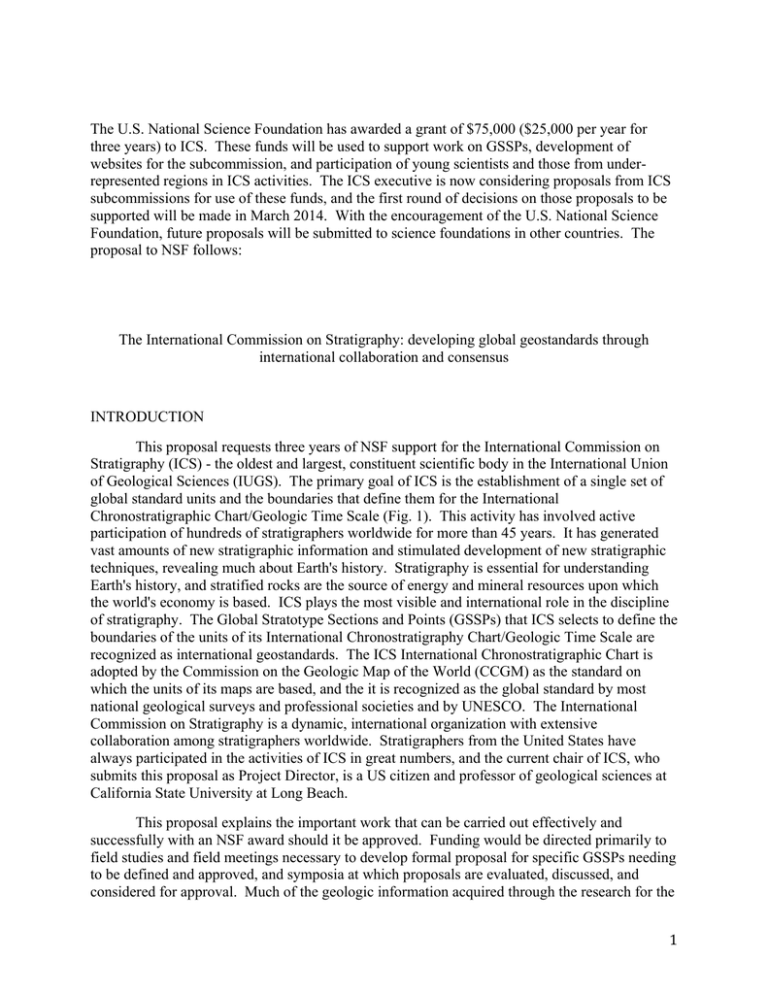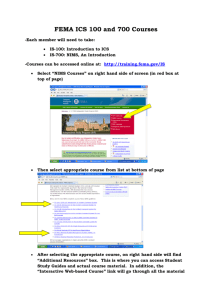1 The U.S. National Science Foundation has awarded a grant of
advertisement

The U.S. National Science Foundation has awarded a grant of $75,000 ($25,000 per year for three years) to ICS. These funds will be used to support work on GSSPs, development of websites for the subcommission, and participation of young scientists and those from underrepresented regions in ICS activities. The ICS executive is now considering proposals from ICS subcommissions for use of these funds, and the first round of decisions on those proposals to be supported will be made in March 2014. With the encouragement of the U.S. National Science Foundation, future proposals will be submitted to science foundations in other countries. The proposal to NSF follows: The International Commission on Stratigraphy: developing global geostandards through international collaboration and consensus INTRODUCTION This proposal requests three years of NSF support for the International Commission on Stratigraphy (ICS) - the oldest and largest, constituent scientific body in the International Union of Geological Sciences (IUGS). The primary goal of ICS is the establishment of a single set of global standard units and the boundaries that define them for the International Chronostratigraphic Chart/Geologic Time Scale (Fig. 1). This activity has involved active participation of hundreds of stratigraphers worldwide for more than 45 years. It has generated vast amounts of new stratigraphic information and stimulated development of new stratigraphic techniques, revealing much about Earth's history. Stratigraphy is essential for understanding Earth's history, and stratified rocks are the source of energy and mineral resources upon which the world's economy is based. ICS plays the most visible and international role in the discipline of stratigraphy. The Global Stratotype Sections and Points (GSSPs) that ICS selects to define the boundaries of the units of its International Chronostratigraphy Chart/Geologic Time Scale are recognized as international geostandards. The ICS International Chronostratigraphic Chart is adopted by the Commission on the Geologic Map of the World (CCGM) as the standard on which the units of its maps are based, and the it is recognized as the global standard by most national geological surveys and professional societies and by UNESCO. The International Commission on Stratigraphy is a dynamic, international organization with extensive collaboration among stratigraphers worldwide. Stratigraphers from the United States have always participated in the activities of ICS in great numbers, and the current chair of ICS, who submits this proposal as Project Director, is a US citizen and professor of geological sciences at California State University at Long Beach. This proposal explains the important work that can be carried out effectively and successfully with an NSF award should it be approved. Funding would be directed primarily to field studies and field meetings necessary to develop formal proposal for specific GSSPs needing to be defined and approved, and symposia at which proposals are evaluated, discussed, and considered for approval. Much of the geologic information acquired through the research for the 1 more than 60 GSSPs already ratified needs to be readily accessible from the websites of ICS and its subcommissions. Improving many of these websites is a high priority for ICS and would also be supported by an award from NSF. Participation of young scientists and those from underrepresented regions in the activities of IUGS and its Commissions and Subcommissions is an important goal of IUGS. Field meetings and symposia hosted by the subcommissions provide excellent opportunities for young scientists to become involved in international scientific collaboration. Funding from NSF would support the participation of these young scientists. The historic funding ICS receives from IUGS, ~$50,000 per year, is "seed money" that is distributed among 16 subcommissions and the Executive. It primarily supports travel for a few key participants of field meetings. Preparation of GSSP proposals requires extensive field investigations of candidate stratigraphic sections and intervals. It also requires field meetings of task groups and subcommission members in order to fully evaluate candidate stratotype sections. The field research has long been supported through research grants that individual stratigraphers have received from their national granting agencies and host institutions. Unfortunately, research grants from these agencies have declined significantly, most recently because of the global economic crisis. In light of this lack of funding for ICS activities, this proposal is submitted to the National Science Foundation. The support requested is $75,000 allocated at $25,000 per year for three years. This support, if awarded, will be directed to focused field investigations and field business meetings on candidate GSSPs, to symposia at which GSSPs are considered for approval, to support the develop of webpages that provide ready access to the vast stratigraphic information developed by ICS activities, and to support the participation of young scientists in activities of the International Commission on Stratigraphy. The funds would give a significant boost to the primary activities and responsibilities of ICS and, in so doing, have a considerable scientific and societal impact. IMPORTANCE OF STRATIGRAPHY Stratigraphy, particularly that part dealing with the establishment of time-relationships within and between sections of stratified rocks worldwide, is essential for understanding the history of Earth processes and environments, the human impact on the Earth system, and the future of the limited biosphere we inhabit. Whereas non-stratified rocks provide evidence of significant events in Earth's history, the stratigraphic record is primary because it is by far the most complete and continuous, because it reveals much about the Earth's surface, its oceans and atmosphere, and its biosphere, and because it can be deciphered with at high temporal resolution. Our knowledge of Earth's history is remarkable. We have documented the origin and growth of continents and ocean basins, the uplift of mountains, and the subsidence of continental margins and interior basins. We have a detailed record of the history of life including evolutionary bursts and mass extinctions, and we have acquired considerable evidence on causative processes, both terrestrial and extra-terrestrial. We have records of global warming and glaciations, both abrupt and long term, of chemical evolution of the oceans and atmosphere and the inter-relationships of the biosphere, lithosphere, atmosphere, and hydrosphere, particularly during times of rapid, extreme change. We have a long record of reversals of the polarity of Earth's magnetic field that have revealed the history of the ocean floor and provides for global correlations. This knowledge gives us an appreciation of both Earth's place in the Cosmos and the brief existence of our own species. Stratigraphy and the information it generates are also essential in the search 2 for the primary energy resources (oil, gas, coal) and strata-bound mineral deposits that sustain our existence. A general knowledge of Earth history has been developed over the past 200 years, but investigations and discoveries of the last 30 years have led to a much richer understanding of inter-relationships in the Earth system, particularly those at Earth's surface. THE INTERNATIONAL COMMISSION ON STRATIGRAPHY (IUGS) History, Purpose, and the ICS International Chronostratigraphic Chart The Geologic Time Scale is based on the rocks that record Earth's history, primarily successions of stratified rocks in which superposition provides for relative ages within a section and region, and biostratigraphy is fundamental for time correlations between regions. Distinctive stratigraphic intervals, characterized biostratigraphically, are the basis for the formal chronostratigraphic units (e.g., Cambrian System, Pleistocene Series, Albian Stage) on which geologic time, and thus Earth history, is expressed (e.g., Cambrian Period, Pleistocene Epoch, Albian Age). Established in the mid 19th century, the units and their biostratigraphic record allowed stratified Phanerozoic rocks to be correlated worldwide, to be mapped, and to be used for paleogeographic, paleoenvironmental, and geotectonic reconstructions, and thus to interpret Earth's history and to explore more effectively for its energy and mineral resources. With the revolutions in Earth sciences in the mid to late 20th century, ranging from plate tectonics to mass extinctions and global Earth systems, the classic 19th century units were found to be seriously deficient for 20th, and even 21st, century Earth science. The chronostratigraphic units of system, series, and stage rank were originally defined on type sections or type areas, often the first locality or section studied, and typically located in western Europe. The units were characterized by their content, generally paleontologic, which served for their being recognized and correlated to strata elsewhere. However, boundaries between successive units were rarely defined, and as stratigraphic studies were extended into other areas away from the stratotype, into new regions, and into stratigraphic successions more complete and more fossiliferous than the stratotypes, it was discovered that many successive units either overlap or are separated by significant stratigraphic gaps. Furthermore, the stratigraphic extent of many units, including the systems, differed significantly between regions with greatly different stratigraphic records, resulting in a proliferation of regional stratigraphic classifications and nomenclature, none of which were formally defined on rigorous standards and by international agreement. Founded in the 1960s under the auspices of the International Union of Geological Sciences, the International Commission on Stratigraphy has as a primary goal the development of a Standard Global Chronostratigraphic (Geochronologic) Scale. This scale is intended to be a hierarchy of chronostratigraphic units of worldwide scope, which will serve as a standard scale for the dating of all rocks everywhere and for relating all rocks everywhere to a world geologic history (Hedberg, 1976: p. 76; Salvador, 1994: p. 85). International teams of stratigraphers were organized into system-based groups (e.g., Subcommission on Cretaceous Stratigraphy) to establish a single set of global units at system, series, and stage rank, and to precisely define boundaries between successive units. The concept of the Global Stratotype Section and Point (GSSP) was adopted. The GSSP is a specific level (or point) in a single stratigraphic section that serves as the lower boundary of the stage (and series and system) that it defines and also as the upper boundary of the underlying stage (and series and system). These GSSPs allow Earth's 3 stratigraphic succession to be subdivided into stages, series, and systems between which there are no overlaps or gaps. A single GSSP serves as the global geostandard that defines a single chronostratigraphic unit of the lowest rank, the stage, and possibly those of higher rank, the series and system. ICS has adopted a list of requirements for selecting GSSPs (Salvador, 1994: p. 90-91). The most important is that the boundary interval in the stratotype section include as many specific stratigrapher markers as possible - biostratigraphic, chemostratigraphic, magnetostratigraphic, sequence stratigraphic - favorable for long-distance time correlation (chrono-correlation). The procedure for selection of GSSPs begins with extensive field investigations of the stratigraphic interval of concern in sections worldwide with the goal of identifying and testing stratigraphic markers that prove most reliable for chrono-correlation. Once candidate stratigraphic markers and sections have been identified and considered, formal proposals are prepared for the one or more sections and points considered the best available by the boundary working group. The proposals are then considered by the relevant subcommission, and if a single proposal receives a super-majority (>60%) of yes votes it is forwarded to ICS for consideration. The voting members of ICS (the executive officers and chairs of all subcommissions) evaluate the proposal. If it receives a super-majority of yes votes, it is then forwarded to the IUGS Executive Committee for ratification. Once ratified, the GSSP is established as a global standard. It is published in Episodes, the journal of IUGS. It should then be dedicated with the installation of a plaque and possibly a "golden spike" (Figs. 2 & 3). The Episodes article documenting the GSSP is then posted to the ICS website (www.stratigraphy.org) in the formal archive of ICS. These extensive requirements and procedures for selection of GSSPs and the chronostratigraphic units they define give validity and authority to them as global geostandards. More than 100 GSSPs will be needed to formally define all the stages (and series and systems) of the Phanerozoic, and 10 to 20 more for the Precambrian. The first GSSP to be ratified - that for the Silurian-Devonian boundary - was completed in 1972. Selection of a GSSP may require many years if not decades. Field investigations must be carried out, using modern integrated stratigraphic studies, including biostratigraphy of several groups of index fossils, chemostratigraphy (carbon, oxygen, and strontium), magnetostratigraphy, cyclostratigraphy and sequence stratigraphy whenever possible. Radiometric dating of volcanic ash beds is essential for providing numerical ages. Original type sections and areas need re-investigation and new sections are considered as well, often in other, far-removed areas. Multi-disciplinary teams must do this work, and must fund the work from their own research budgets and in some instances their personal budgets because ICS funds are most limited. Since 1972, 63 GSSPs have been ratified, although a few have proved to be deficient and are being re-evaluated. On average 2-4 GSSPs were ratified most every year for the last 20 years. Ratified GSSPs are located in China (10), the United Kingdom (9), Italy (9), the United States (7), France (5), Spain (5), the Czech Republic (3), Canada (2), Sweden (2), Morocco (2), Austria (1), Germany (1), Portugal (1), Malta (1), Tunisia (1), Egypt (1), Kazakhstan (1), and Uzbekistan (1), and one (for the Holocene) is in an ice core from Greenland. Some of these GSSPs are located in nature preserves and parks. Dedication ceremonies have been attended by local government officials and by journalists (Fig. 4), and educational exhibits for the public have been installed at the sites as well (Fig. 5). The Standard Global Chronostratigraphic Scale is now referred to as the ICS International Chronostratigraphic Chart (ICS Chart). It shows the single set of global stages, series, and systems being formally defined by GSSPs, as well as those GSSPs that have been 4 ratified by IUGS (Fig. 1). Also, as determined by the subcommissions, the ICS Chart shows numerical ages calibrated for the boundaries between successive units. The numerical ages are subject to revision; thus GSSPs (specific points in specific stratotype sections) define the boundaries, not the numerical ages. The ICS Chart shows both chronostratigraphic and the equivalent geochronologic units and with numerical ages added is considered the Geologic Time Scale. The ICS Chart and the GSSP documents are posted on the ICS website (stratigraphy.org). They are regularly revised and updated, and past versions are kept in the ICS archive. The ICS Chart has now been translated into French, Spanish, Japanese, Chinese, Norwegian, Spanish (Castilian), Basque, and Catalan; translations into Russian, Finnish, American Spanish, are in progress. The ICS Chart was printed by the Commission on the Geological Map of the World (CGMW) and the organizing committee of the 34th International Geologic Congress and distributed to all participants of the Congress. The ICS Chart serves as the stratigraphic standard for the wealth of maps produced by CGMW. The ICS Chart, earlier editions, and Table of GSSPs on the ICS website are included within the thesaurus/dictionary for GeoSciML, an interchange format for geoscience data being developed by the IUGS Commission on the Management and Application Geoscience Information (CGI). GSSPs, as global geostandards, have recently received the attention of international groups concerned with conservation, such as UNESCO (Geoparks Program), IUGS (Geosites Program) and ProGEO (Geosites and Geoparks initiatives). To date, the GSSP process of ICS has stimulated focused studies in stratigraphy that greatly advanced knowledge of Earth's stratigraphic record. Forty-five years of work by ICS and its Subcommissions has: generated a huge body of stratigraphic information for the entire geological column from hundreds of sections worldwide and from deep-sea and ice cores. established formal global chronostratigrapic units for much of the geological column with 63 of them now precisely defined by ratified GSSPs. driven significant advances in biostratigraphy and the taxonomy, paleoecology, and paleogeography of index fossil groups on which it is based. stimulated the development, testing, and refinement of more modern tools for stratigraphic correlation, including magnetostratigraphy, chemostratigraphy, and cyclostratigraphy with astronomical-tuning of sedimentary cycles. produced the International Stratigraphic Guide, which then served as the template for many national stratigraphic codes. encouraged the development of modern techniques in isotope geochronology by providing a well-defined chronostratigraphy in which to integrate radiometric dates. Organization 5 ICS consists of a three person executive (Chair, Vice Chair, Secretary-General) and 16 subcommissions, each with approximately 20 voting members and officers and with 20 to more than 100 corresponding members. The subcommissions of ICS together have more than 350 voting members; 14 subcommissions focus on particular systems, 1 on the Precambrian, and 1on stratigraphic classification. When the corresponding members of subcommissions are added, many hundreds of stratigraphers worldwide participate in the activities of ICS, and several hundred more have participated over the 45-year history of ICS. The voting members of the Full Commission (i.e. the 3 members of the Executive and the chairs of the 16 subcommissions) represent six countries: United Kingdom (6 members), Canada (4), Italy (3), USA (2), China (2), and Australia (1). Among all subcommission officers and the ICS executive, 15 countries are represented: United Kingdom (9 members), Canada (9), USA (8), China (7), Italy (6), Australia (3), Spain (2), Russia (2), Belgium (1), Czech Republic (1), Estonia (1), France (1), Germany (1), Sweden (1), Switzerland (1). The voting members of all subcommissions represent 40 countries: USA (58), China (37), United Kingdom (32), Russia (31), Canada (25), Germany (24), Italy (21), Australia (16), Spain (13), France (12), Japan (10), New Zealand (8), Argentina (7), Belgium (7), Netherlands (7), Brazil (6), Poland (6), Czech Republic (5), Denmark (5), Sweden (5), Switzerland (5), Hungary (4), India (3), Korea (3), South Africa (3), Tunisia (2), Austria (2), Estonia (2), Finland (2), Iran (2), Bulgaria (1), Colombia (1), Croatia (1), Greece (1), Lithuania (1), Namibia (1), Norway (1), Portugal (1), Turkey (1), and Ukraine (1). Furthermore, ICS maintains contacts with many national stratigraphic committees and their individual members. Besides its work on GSSPs and archiving the global geostandards (ICS Chart and Table of GSSPs) on the ICS website (www.stratigraphy.org), the activities and products of ICS are many and varied. The ICS Subcommission on Stratigraphic Classification produced the 1st and 2nd editions of the International Stratigraphic Guide, and that subcommission is now producing a series of papers on the subdisciplines of stratigraphy that are excellent educational products. The work of all the subcommissions generates regular symposia and field meetings and numerous, varied publications every year. ICS holds major programs and important business meetings at the International Geological Congress and in intervening years at one or more ICS workshops or the International Congress on Stratigraphy. ICS has established a formal link with the Geobiodiversity Database at the Nanjing Institute of Geology and Palaeontology, Chinese Academy of Sciences. This database, readily and freely accessible to stratigraphers worldwide, is available to ICS as an archive for all stratigraphic information generated by ICS, particularly biostratigraphic data from stratigraphic sections. THE CHALLENGE For most if its 45-year history, The International Commission on Stratigraphy operated with little notice in the greater Earth science community. Even among stratigraphers, the work of ICS was largely carried out by small, largely independent groups of stratigraphic paleontologists within separate ICS subcommissions. Decisions of subcommissions on GSSPs were routinely approved but were of immediate consequence primarily to the small community of stratigraphers who applied them. But, this has changed in the last tens years with the wide visibility today of the ICS International Chronostratigraphic Chart and its wide acceptance as the global standard 6 by geologists and professional societies worldwide, by most national geological surveys, and by international organizations from CGMW to UNESCO. The accomplishments of ICS in stabilizing chronostratigraphic classification and the extensive, integrated stratigraphic studies required to do so have proved essential and fundamental for understanding major Earth events such as the timing, rate, nature and cause of the Permian-Triassic mass extinction and the astronomically driven climate cycles of the Neogene and Quaternary. The integration of biostratigraphy, magnetostratigraphy, chemostratigraphy, sequence stratigraphy, cyclostratigraphy, high-precision radiometric dating and astronomical tuning in investigation and selection of GSSPs has greatly increased the range of disciplines represented by participants in ICS and expanded the scientific questions addressed. The recently ratified ICS decision on definition of the Quaternary System/Period and re-definition of the base of the Pleistocene Series/Epoch impacted and thus caught the attention of a very large Earth science community that included 1) several national geological surveys (e.g., those of USA, Italy, Russia, and China), 2) the large group of Quaternary specialists represented by INQUA (the International Union of Quaternary Research), and 3) the marine stratigraphers and the paleo-oceanography and paleoclimatology communities with whom they collaborate. While controversial, the ICS decision settled a 25-year conflict over the Quaternary. The recent global public attention given the Anthropocene by National Geographic and as a cover story by the Economist arose from the proposal that the Anthropocene be considered by ICS as a formal unit on the ICS Chart, namely the Anthropocene Epoch defined by a GSSP or GSSA (Global Standard Stratigraphic Age). That this issue is placed before the International Commission on Stratigraphy is testament to the recognition and respect given ICS by the Earth science community and to the authority and validity of its decisions establishing global geostandards. The highly visible and authoritative position of ICS in stratigraphy today presents the challenge of how ICS can best meet the responsibilities of that position. Furthermore, its relatively recent attainment of that visibility should be responded to so that it can move more quickly towards its goals. Enhancing its greatly limited funding would have a most significant impact for advancing three major goals. Accordingly, three-years of support is requested. Selection of GSSPs is the primary objective of ICS, fundamental to completely establishing the Standard Global Chronostratigraphic Scale. Accordingly, 60-70% of funds requested will be targeted to specific field studies, field business meetings, and subcommission symposia with greatest potential for progress on GSSPs. The work of ICS is done in the subcommissions. Subcommission members carry out necessary field studies of candidate GSSPs and attend field meetings and international symposia where candidate GSSPs are presented and considered for recommendation to ICS. The ICS budget allocation to each subcommission provides very limited support to these activities. This is the greatest hindrance to ICS attaining its primary goal. It is the responsibility of ICS to maintain an archive with documentation of the global geostandards it establishes. Hard copy is no longer acceptable. It must be web based and freely accessible. It must be hosted on the websites of ICS and its subcommissions. As the most visible website, that of ICS must maintain the archive of the global geostandards, i.e. present and prior versions of the ICS International Chronostratigraphic Chart and the Table of GSSPs, as well as archive all ICS business. Although all subcommissions have websites, many are out-ofdate and contain little documentation of decisions by the subcommissions. Accordingly, 10-15% 7 of funds requested will be targeted to rejuvenation of websites of the subcommissions. These websites should be the primary portals to stratigraphic information on the worldwide web. Subcommissions must rejuvenate themselves through the recruitment of young scientists. Long-term subcommission members provide valuable experience and a rich store of stratigraphic knowledge necessary to select GSSPs, but they eventually retire both from ICS and from their professions. They must be replaced or the science will die. Many subcommission members began their association with ICS early in their career as the result of carrying out research on candidate sections for GSSPs. Subcommission business meetings provided them the opportunities to present their research results to attentive audiences, to meet potential mentors, and to develop fruitful collaborations, and thus served as their pathway into international scientific collaboration and moving into positions as voting members and officers of subcommissions. Accordingly, 20% of funds requested will be targeted to support the participation in ICS activities of young scientists, particularly those from under-represented regions. ANTICIPATED RESULTS The funds requested would allow ~12 specific projects on GSSPs (4 per year) to advance significantly. Field investigations, field business meetings, and subcommission symposia providing the greatest potential for success would be supported, resulting in a possible doubling of the rate at which GSSPs are ratified. The funds would allow for services to design and build six more subcommission websites than would otherwise be possible over the next three years. ICS is forming an Executive Task Group on ICS Websites with the goal of making the ICS website and those of the subcommissions the primary archives of all documentation for all GSSPs and the units of the ICS Chart that they define. The funds would allow 10-15 young scientists and scientists from under-represented regions to attend field business meetings and symposia of subcommissions. To maintain the momentum that would be generated by NSF funds, ICS would actively seek similar grants from other national research foundations to follow upon an award from NSF. DISTRIBUTION OF FUNDS A grant award for ICS will be managed by the Stan Finney, the PI on the proposal and also the Chair of ICS (until August 2016; followed by 4 years as past-chair). The ICS Executive will regularly invite requests from its subcommissions for support for specific field investigations, field business meetings, and subcommission symposia, for webpage development, and for support of specific young (under-represented) scientists attending subcommission activities. The ICS Executive (Chair, Vice Chair, and Secretary-General) will evaluate and decide on requests. REFERENCES CITED: 8 Hedberg, H.D., 1976, International Stratigraphic Guide, John Wiley & Sons: New York, 200 pages. Salvador, A., ed., 1994, International Stratigraphic Guide, 2nd edition, The International Union of Geological Sciences and The Geological Society of America: Boulder, Colorado, 214 pages. Figure 1. August 2012 version of ICS International Chronostratigraphic Chart Figure 2. Plaque for GSSP for Thanetian Stage, Zumaia, the Basque Country, Spain. 9 Figure 3. "Golden Spike" in place in bed marking base of Thanetian Stage, Zumaia, Spain. Figure 4. GSSP dedication ceremony at Zumaia, Spain was led by the governor (center) of Gipuzkoa province, the Basque Country, Spain, and the mayor of Zumaia (2nd from left). 10 Figure 5. Educational exhibit for the public installed at popular beach at Zumaia where GSSPs for Selandian and Thanetian stages (Paleocene Series; Paleogene System) are located. Governor and mayor to the right of the exhibit uncover the exhibit with numerous journalists photographing and filming the event. 11 12




